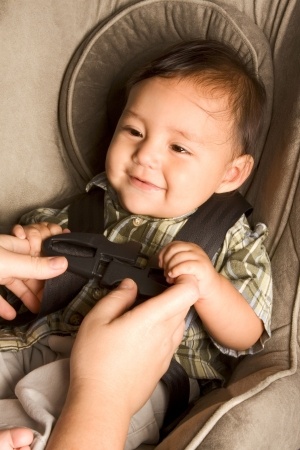This past winter, vital information about car seat safety made the rounds on social media and in the news.
As it turns out, while it may be a common wintertime practice to bundle up your baby before heading out the door, car seats aren’t designed for use with winter wear.
In fact, it can be dangerous—strapping your child’s harness over their jacket creates a gap between their body and seatbelt, making the harness too loose to be effective in a car crash.
Winter may be wrapping up and we’re starting to shed the layers, but car seat safety remains an important issue year-round. According to the Canadian Paediatric Society, more than 2,500 children between the ages of one and four are injured or killed in car collisions in Canada each year.
If you’re about to welcome a new baby into your family, here’s everything you need to know about car safety for infants and toddlers:
When the air is still nippy, use blankets layered over top of your infant’s car seat harness.
Dress your child in thinner layers, which will ensure that the harness is tightly and securely fastened around their body. Alternately, if you’re heading out somewhere for the day, you can also clip their harness first, then put their jacket on backwards, with the coat acting like a blanket. However, don’t put anything under or behind their bodies.
Choose a car seat that fits your child and learn how to strap them in correctly.
To make sure your child is secure, see how many fingers you can fit between your child’s collarbone and the shoulder harness. Any more than one, and it’s too loose. While using a rear-facing car seat, the chest clip should sit at armpit level, while the harness straps should be at or slightly below your child’s shoulder level. Once your child has graduated to a forward-facing car seat, the harness straps should be at or slightly above your child’s shoulder level.
Make sure the car seat is installed correctly.
Installing a car seat is a higher stakes game than Ikea furniture assembly, which is why this is one instruction manual that you won’t want to throw out! Read through it carefully to ensure the seat is secure and in place.
If you’re unsure if you’ve installed it correctly and need a second opinion, car seat clinics are offered across the country, including by local public health departments. For upcoming events, check out Transport Canada’s website to learn more about the community groups in your area who host these workshops.
Choose and place a car seat according to weight—not age.
Nobody wants their children to grow up too fast—so why rush your baby or toddler up into the next size of seat? We don’t blame you if you’re eager to see your baby’s smiling face, which is why backseat travel mirrors are a perfect option while you wait for them to grow.
In the meantime, rear-facing seats should be used until your child is approximately 10 kg. This usually happens around one year of age, but it may not happen until later, and some rear-facing car seats are designed for the use of toddlers up to 20 kg in size. Remember, it is encouraged to keep your child in a rear-facing car seat for as long as possible as long as he/she is still below the car seat’s weight and height limits and fits in the car seat correctly
When it comes to sizing and placement, carefully follow the manufacturer’s height and weight recommendations. As children grow, they can be switched to a forward-facing seat and then later a booster seat—but always be in the back seat, as air bags are not designed for children. Finally, while it may require a bit more stretching on your part, the middle seat is the safest place for your child. This will ensure they’re the furthest away from the door in the event of a crash.
Ensure the car seat meets Canadian Motor Vehicle Safety Standards (CMVSS).
Having a baby is expensive, which is why used or borrowed baby equipment is helpful. However, when it comes to car seats, do your research first. Has it ever been involved in an accident? Are there any defects or safety recalls on the product? Does it have all its parts, including a user manual? Have the expiry date passed? (You’ll find this date in the moulded plastic shell.) Finally, regardless of whether you’re buying new or used, make sure the seat has a National Safety Mark sticker.

